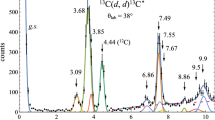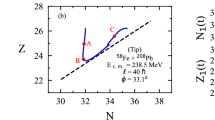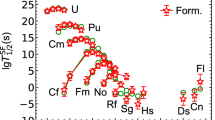Abstract
In the framework of a modified Fisher model, the ratio of the symmetry-energy coefficient to temperature (a sym /T) is extracted from the fragment produced in the 124, 136Xe induced reactions using the isobaric yield ratio methods based on different approximations. It is found that for nuclei with the same neutron excess (I ≡ N − Z) increases when the mass of the fragment increases, while for isobar a sym /T decreases when I increases. It is also found that the extracted a sym /T of the nucleus has very little dependence on the n/p ratio of the projectile, target, and the incident energies in the reaction.
Similar content being viewed by others
References
B.-A. Li et al., Phys. Rep. 464, 113 (2008).
J.M. Lattimer, M. Prakash, Phys. Rep. 333, 121 (2000).
J.M. Lattimer, M. Prakash, Astrophys. J. 550, 426 (2001).
J.M. Lattimer, M. Prakash, Science 304, 536 (2004).
P. Danielewicz et al., Science 298, 1592 (2002).
V. Baran et al., Phys. Rep. 410, 335 (2005).
A.W. Steiner et al., Phys. Rep. 411, 325 (2005).
L.-W. Chen et al., Phys. Rev. C 72, 064309 (2005).
J. Xu et al., Phys. Rev. C 77, 014302 (2008).
M.B. Tsang et al., Phys. Rev. Lett. 86, 5023 (2001).
M.B. Tsang et al., Phys. Rev. C 64, 041603(R) (2001).
S. Kowalski et al., Phys. Rev. C 75, 014601 (2007).
H.S. Xu et al., Phys. Rev. Lett. 85, 716 (2000).
A. Ono et al., Phys. Rev. C 68, 051601(R) (2003).
G.A. Souliotis et al., Phys. Rev. C 73, 024606 (2006).
Ad.R. Raduta, F. Gulminelli, Phys. Rev. C 75, 024605 (2007).
Y.G. Ma et al., Phys. Rev. C 71, 054606 (2005).
Y.G. Ma et al., Phys. Lett. B 390, 41 (1997).
Y.G. Ma et al., Phys. Rev. C 60, 024607 (1999).
M.B. Tsang et al., Eur. Phys. J. A 30, 129 (2006).
P. Zhou et al., Phys. Rev. C 84, 037605 (2011).
D.Q. Fang et al., J. Phys. G: Nucl. Part. Phys. 34, 2173 (2007).
R.W. Minich et al., Phys. Lett. B 118, 458 (1982).
A.S. Hirsch et al., Nucl. Phys. A 418, 267c (1984).
A.S. Hirsch et al., Phys. Rev. C 29, 508 (1984).
M. Huang et al., Phys. Rev. C 81, 044620 (2010).
C.-W. Ma et al., Phys. Rev. C 83, 064620 (2011).
D. Henzlova et al., Phys. Rev. C 78, 044616 (2008).
P. Napolitani et al., Phys. Rev. C 76, 064609 (2007).
A. Bonasera et al., Phys. Rev. Lett. 101, 122702 (2008).
M.E. Fisher, Rep. Prog. Phys. 30, 615 (1967).
C.F. von Weizsäcker, Z. Phys. 96, 431 (1935).
H.A. Bethe, R.F. Bacher, Rev. Mod. Phys. 8, 82 (1936).
P. Danielewicz, J. Lee, Nucl. Phys. A 818, 36 (2009).
S.J. Lee, A.Z. Mekjian, Phys. Rev. C 82, 064319 (2010).
H. Jiang et al., Phys. Rev. C 85, 024301 (2012) and references therein.
A.E.S. Green, D.F. Edwards, Phys. Rev. 91, 46 (1953).
C.W. Ma et al., Phys. Rev. C 79, 034606 (2009).
C.W. Ma, S.S. Wang, Chin. Phys. C 35, 1017 (2011).
C. W. Ma et al., Chin. Phys. B 18, 4781 (2009).
C.W. Ma et al., J. Phys. G: Nucl. Part. Phys. 37, 015104 (2010).
D.Q. Fang et al., Phys. Rev. C 61, 044610 (2000).
G. Audi et al., Nucl. Phys. A 729, 337 (2003).
Author information
Authors and Affiliations
Corresponding author
Additional information
Communicated by B. Ananthanarayan
Rights and permissions
About this article
Cite this article
Ma, CW., Pu, J., Wei, HL. et al. Symmetry energy extracted from fragments in relativistic energy heavy-ion collisions induced by 124,136Xe. Eur. Phys. J. A 48, 78 (2012). https://doi.org/10.1140/epja/i2012-12078-5
Received:
Revised:
Accepted:
Published:
DOI: https://doi.org/10.1140/epja/i2012-12078-5




